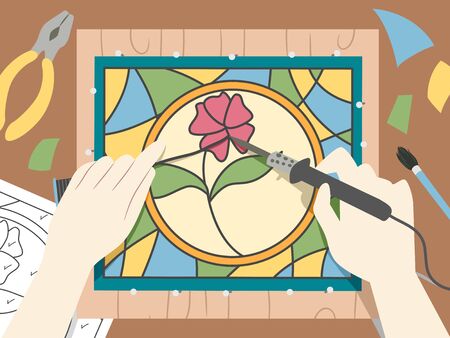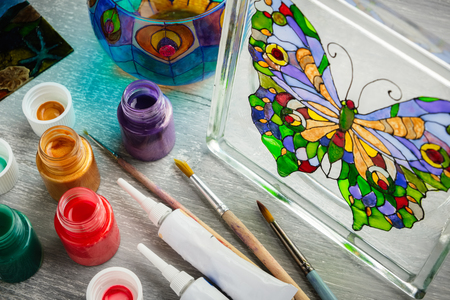
So, how exactly is stained glass transformed from conception to final product?
Step One: Stained Glass Design.
Stained glass making is, first and foremost, an art. Therefore, the process must begin with the artist. To begin a stained glass project, an artist creates a composition sketch of the final piece in its entirety. These drawings are full-sized and referred to as “cartoons”. Cartoons include the shapes, colors, and intricate details of each individual piece of glass.
Step Two: Outline & Glass Cutting
Once the initial design is complete, each section is outlined to scale on corresponding glass pieces. This outline is typically painted on using a white lime wash, and helps the artist visualize and fine-tune the final project. Guidelines for particularly detailed aspects of the design, such as faces, may be outlined on the back and eventually rubbed away.
After the panels have been outlined, the glass pieces are cut to fit the blueprint. Special tools are used to contour the glass pieces exactly to get the desired shape. A dividing iron with a heated tip breaks the glass, which is then chipped further with a grozing iron or grozing pliers to achieve the precise size and shape of the outline.
Step Three: Painting the Glass

Following the application of the paint, the glass pieces are then fired in a kiln, melding the color directly and permanently into the glass.
Step 4: Assembly.
The final step of completing a stained glass project is its assembly, which is comprised of four smaller steps: framing, binding, glazing, and cementing. The frame for the final product is built using narrow, flexible lead strips called lead cames. The cames are manipulated to fit around the various shapes and arrange the individual pieces of glass according to the final composition.
Once every panel is in place, they are secured first through glazing, and then cementing. The lead frame and glass pieces are bound together with a solder glaze, a lead and tin alloy that melts at low temperatures and sets quickly.
Lastly, the final composition is cemented using a semi-liquid cement, which further secures the pieces in place and also serves as a waterproof coat.
Understanding the process of stained glass creation helps us see the value in stained glass windows as a work of art and an addition to any home or commercial building.
Whether you’re looking to restore stained glass windows to their original quality or add brand new ones to your home or business, the team at Cumberland Stained Glass can provide you with the services you need! We offer a wide range of stained glass services to the Mid-Atlantic region and beyond, in an effort to keep this unique type of beauty alive.
Contact us today to book our premier services for all of your stained glass needs!
